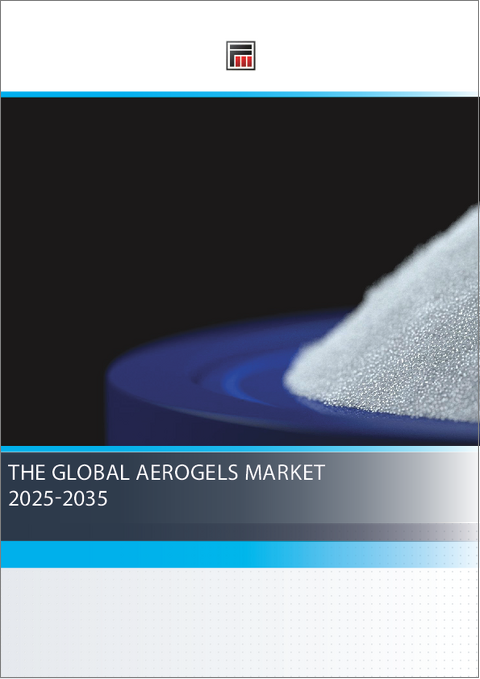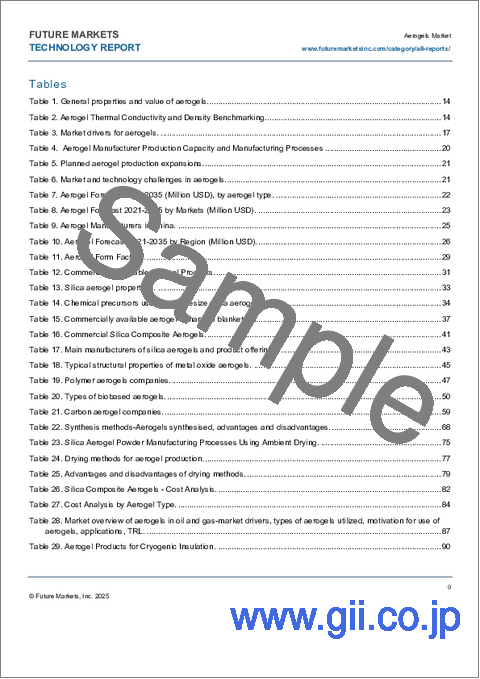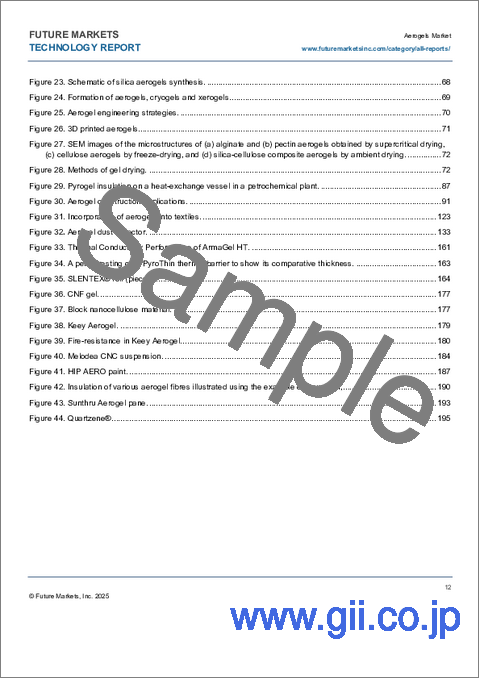|
|
市場調査レポート
商品コード
1661288
エアロゲルの世界市場(2025年~2035年)The Global Aerogels Market 2025-2035 |
||||||
|
|||||||
| エアロゲルの世界市場(2025年~2035年) |
|
出版日: 2025年02月27日
発行: Future Markets, Inc.
ページ情報: 英文 208 Pages, 56 Tables, 44 Figures
納期: 即納可能
|
- 全表示
- 概要
- 目次
世界のエアロゲル市場は大きく成長し、ニッチな特殊材料から重要な商業部門へと変貌しました。この成長は、超低熱伝導率(0.015W/m-K)、非常に軽い性質(80~150kg/m3)、高気孔率、難燃性など、エアロゲルの卓越した特性によって後押しされています。シリカエアロゲルは、主に石油・ガス、建築断熱、工業用途に使用され、依然として優位を保っています。しかし、ポリマーベースエアロゲルは、柔軟性と加工性の向上により加速度的な成長を見せており、輸送、アパレル、航空宇宙用途にますます魅力を増しています。カーボンエアロゲルとバイオベースエアロゲルは、エネルギー貯蔵、触媒、持続可能な材料といった特殊な用途で主要セグメントとして浮上しています。
地域別では、現在北米が収益をリードしていますが、中国が急速に製造能力を拡大しています。欧州市場は、厳しい建築断熱規制と持続可能性への取り組みにより、好調を維持しています。もっとも急成長している応用分野は電気自動車バッテリーの熱管理で、メーカーが熱暴走防止と防火にエアロゲルソリューションを採用しているため、年率40%超で拡大しています。競合情勢は著しく進化しており、既存企業が生産能力を拡大する一方で、Guangdong AlisonやIBIH Advanced Materialsなどの中国メーカーが急速に生産規模を拡大しています。ニッチな用途や先進の製法に特化した小規模な専門メーカーも登場しています。
技術の進歩は極めて重要で、常圧乾燥技術は従来の超臨界法に比べて生産コストを削減しています。連続ロールツーロールプロセスを含む製造技術の革新は拡張性を向上させ、新しいハイブリッド製法と複合構造は能力を拡大しました。特定の用途では高い生産コストと加工上の課題が残る一方、製造規模が拡大するにつれて、こうした障壁は徐々に小さくなっています。世界のエネルギー効率規制、建築基準法、電気自動車の安全基準、産業の脱炭素化構想などの市場促進要因は、さまざまな部門でエアロゲル採用の価値提案を強化し続けています。
今後、エアロゲル市場は、生産コストがさらに低下し、特に輸送、持続可能な建材、エネルギー貯蔵、高性能工業用途など、新たな用途が登場していることから、引き続き力強い成長が見込まれます。業界全体の軽量かつ高効率な材料を求める動向は、エアロゲルの市場プレゼンス拡大の強力な基盤となっています。
当レポートでは、世界のエアロゲル市場について調査し、市場の促進要因と動向、生産能力、技術課題、市場予測、特許、企業プロファイルなどの情報を提供しています。
目次
第1章 エグゼクティブサマリー
- エアロゲルの特性
- エアロゲルの用途
- エアロゲル市場における競合要因
- 市場促進要因と動向
- エアロゲルのメーカーと生産能力
- 市場と技術の課題
- 市場規模と予測(2021年~2035年)
- エアロゲルタイプ別
- 市場別
- 地域別
第2章 イントロダクション
- エアロゲル
- エアロゲルの起源
- 分類
- エアロゲルフォーム
- 市販のエアロゲル
- シリカエアロゲル
- 特性
- 製品
- コスト
- 主な参入企業
- エアロゲルライクポリマーフォーム
- 特性
- エアロゲルライクポリマーフォームの用途には以下が含まれます。
- 金属酸化物エアロゲル
- 有機エアロゲル
- ポリマーベースエアロゲル
- バイオベースエアロゲル(バイオエアロゲル)
- カーボンエアロゲル
- 3Dプリントエアロゲル
- 窒化炭素
- ハイブリッド、複合エアロゲル
- 混合酸化物エアロゲル
- 金属酸化物エアロゲル複合材料
- カーボンベースエアロゲル複合材料
第3章 生産方式
- 概要
- ゾルゲル法
- エアロゲルの3Dプリンティング
- 乾燥法
- 乾燥法の概要
- 超臨界乾燥
- 常圧乾燥
- 急速超臨界抽出(RSCE)
- 利点と欠点
- コスト
第4章 エアロゲルの市場と用途
- 競合情勢
- 石油・ガス
- 概要
- 用途
- 建築・建設
- 概要
- 持続可能な断熱材のタイプ
- 用途
- エネルギー貯蔵
- 概要
- 用途
- 生物医学
- 概要
- 用途
- コールドチェーン包装
- 概要
- 電子、通信
- 概要
- 用途
- ろ過、分離、吸着
- 概要
- 用途
- テキスタイル
- 概要
- 用途
- 食品
- 概要
- 触媒
- 塗料・コーティング
- 航空宇宙・防衛
- 概要
- 用途
- 化粧品
- 概要
- 自動車
- 概要
- EVバッテリー
- その他の市場と用途
第5章 エアロゲルの特許
- 特許出願
第6章 エアロゲル企業プロファイル(50社の企業プロファイル)
第7章 調査範囲と調査手法
第8章 参考文献
The global aerogel market has experienced remarkable growth, transforming from a niche specialty material into a significant commercial sector. This growth is fueled by aerogels' exceptional properties, including ultra-low thermal conductivity (as low as 0.015 W/m-K), extreme lightweight nature (80-150 kg/m3), high porosity, and fire resistance. Silica aerogels continue to dominate, primarily serving oil and gas, building insulation, and industrial applications. However, polymer-based aerogels are showing accelerated growth rates due to enhanced flexibility and processability, making them increasingly attractive for transportation, apparel, and aerospace applications. Carbon aerogels and bio-based variants are emerging as important segments for specialized applications in energy storage, catalysis, and sustainable materials.
Regionally, North America currently leads in revenue generation, though China is rapidly expanding manufacturing capacity. The European market remains strong, driven by stringent building insulation regulations and sustainability initiatives. The fastest-growing application sector is electric vehicle battery thermal management, expanding at over 40% annually as manufacturers adopt aerogel solutions for thermal runaway prevention and fire protection. The competitive landscape has evolved significantly, with established players expanding capacity while Chinese manufacturers such as Guangdong Alison and IBIH Advanced Materials rapidly scale up production. Smaller specialized producers have emerged focusing on niche applications and advanced formulations.
Technology advancements have been pivotal, with ambient pressure drying techniques reducing production costs compared to traditional supercritical methods. Manufacturing innovations including continuous roll-to-roll processes have improved scalability, while new hybrid formulations and composite structures have expanded performance capabilities. While high production costs and processing challenges persist for certain applications, these barriers are progressively diminishing as manufacturing scale increases. Market drivers including global energy efficiency regulations, building codes, EV safety standards, and industrial decarbonization initiatives continue to strengthen the value proposition for aerogel adoption across multiple sectors.
Looking forward, the aerogel market is positioned for continued strong growth as production costs decrease further and new applications emerge, particularly in transportation, sustainable building materials, energy storage, and high-performance industrial applications. The trend toward lightweight, high-efficiency materials across industries provides a strong foundation for aerogels' expanding market presence.
"The Global Aerogels Market 2025-2035" provides an in-depth analysis of the rapidly expanding global aerogels industry, with detailed segmentation by aerogel type, application sector, and geographic region. The executive summary covers aerogel properties, market position, drivers, production capacities, and technology challenges. The introduction section presents aerogel classification, commercially available types, and analysis of silica, polymer, metal oxide, organic, carbon, and hybrid aerogel variants. Production methodology content includes manufacturing processes from sol-gel synthesis through aging, surface modification, and drying techniques with cost assessments and manufacturing process evaluations.
Application sector analysis covers fifteen markets with drivers, aerogel types, performance advantages, technology readiness levels, and growth projections for building insulation, oil and gas, EV batteries, energy storage, biomedical applications, and textiles. Regional analysis examines China's expanding production capacity compared to North America and Europe's focus on high-value applications. The competitive landscape section contains profiles of 45 aerogel manufacturers.
The report features 40 tables and 45 figures showing market trends, material properties, manufacturing processes, and performance metrics, plus patent analysis tracking innovation activity. The forecasts through 2035 segment the market by aerogel type, application sectors, and geographical regions for precise market sizing and opportunity identification in this advanced materials sector.
Report Contents include:
- Aerogel properties
- Applications overview
- Competitive landscape
- Market drivers and trends
- Production capacities
- Technology challenges
- Market forecasts 2021-2035
- Types of Aerogels
- Silica aerogels
- Polymer-based aerogels
- Metal oxide aerogels
- Organic and biobased aerogels
- Carbon aerogels
- 3D printed aerogels
- Hybrid and composite aerogels
- Production Methods
- Markets and Applications
- Oil and gas
- Building and construction
- Energy storage
- Biomedical
- Cold-chain packaging
- Electronics and telecommunications
- Filtration and separation
- Textiles
- Food
- Catalysts
- Paint and coatings
- Aerospace and defense
- Cosmetics
- Automotive and EV batteries
- Other applications
- Patent Analysis
- Innovation trends
- Key patent holders
- Company Profiles (50 manufacturers)
- Established market leaders
- Emerging specialists
- Regional manufacturers. Companies profiled include: ABIS Aerogel Co., Active Aerogels, Aerofybers Technologies SL, Aerogel Core Ltd, Aerogel Coating Technologies, aerogel-it GmbH, Aerogel Technologies LLC, AeroShield Materials, Armacell International S.A., Aspen Aerogels Inc., BASF SE, Blueshift Materials Inc., Cabot Corporation, Cellutech AB (Stora Enso), Dragonfly Insulation, Elisto GmbH, Enersens SAS, Fibenol, Fuji Silysia Chemical Ltd., Gelanggang Kencana Sdn. Bhd., Green Earth Aerogel Technologies, Guangdong Alison Hi-Tech Co. Ltd., Hebei Jinna Technology Co. Ltd., Hokuetsu Toyo Fibre Co. Ltd., IBIH Advanced Materials, Keey Aerogel and more
- Market Forecasts 2021-2035
- By aerogel type
- By application market
- By geographic region
TABLE OF CONTENTS
1. EXECUTIVE SUMMARY
- 1.1. Aerogel properties
- 1.2. Aerogel applications
- 1.3. Competitive factors in the aerogels market
- 1.4. Market drivers and trends
- 1.5. Aerogel producers and capacities
- 1.6. Market and technology challenges
- 1.7. Market size and forecast 2021-2035
- 1.7.1. By aerogel type
- 1.7.2. By market
- 1.7.3. By region
2. INTRODUCTION
- 2.1. Aerogels
- 2.1.1. Origin of Aerogels
- 2.1.2. Classification
- 2.1.3. Aerogel Forms
- 2.1.4. Commercially available aerogels
- 2.2. Silica aerogels
- 2.2.1. Properties
- 2.2.1.1. Thermal conductivity
- 2.2.1.2. Mechanical
- 2.2.1.3. Silica aerogel precursors
- 2.2.2. Products
- 2.2.2.1. Monoliths
- 2.2.2.2. Powder
- 2.2.2.3. Granules
- 2.2.2.4. Blankets
- 2.2.2.5. Aerogel boards
- 2.2.2.6. Aerogel renders
- 2.2.2.7. Silica aerogel from sustainable feedstocks
- 2.2.2.8. Silica composite aerogels
- 2.2.2.8.1. Organic crosslinkers
- 2.2.2.8.2. Commercial activity
- 2.2.3. Cost
- 2.2.4. Main players
- 2.2.1. Properties
- 2.3. Aerogel-like polymer foams
- 2.3.1. Properties
- 2.3.2. Applications for aerogel-like polymer foams include:
- 2.4. Metal oxide aerogels
- 2.5. Organic aerogels
- 2.5.1. Polymer-based aerogels
- 2.5.2. Biobased aerogels (bio-aerogels)
- 2.5.2.1. Overview
- 2.5.2.2. Sustainable Feedstocks
- 2.5.2.2.1. Silica aerogels derived from waste sources
- 2.5.2.2.2. Commercial development
- 2.5.2.2.3. Textile waste into high-value aerogel materials
- 2.5.2.3. Cellulose aerogels
- 2.5.2.3.1. Cellulose nanofiber (CNF) aerogels
- 2.5.2.3.2. Cellulose nanocrystal aerogels
- 2.5.2.3.3. Bacterial nanocellulose aerogels
- 2.5.2.3.4. Lignin aerogels
- 2.5.2.3.5. Alginate aerogels
- 2.5.2.3.6. Starch aerogels
- 2.5.2.3.7. Chitosan aerogels
- 2.5.2.3.8. Protein aerogels
- 2.5.2.3.8.1. Albumin aerogels
- 2.5.2.3.8.2. Casein aerogels
- 2.5.2.3.8.3. Gelatin aerogels
- 2.5.2.3.9. Silk fiber
- 2.5.3. Carbon aerogels
- 2.5.3.1. Carbon nanotube aerogels
- 2.5.3.2. Graphene and graphite aerogels
- 2.6. 3D printed aerogels
- 2.6.1. Carbon nitride
- 2.6.1.1. Gold
- 2.6.1.2. Cellulose
- 2.6.1.3. Graphene oxide
- 2.6.1. Carbon nitride
- 2.7. Hybrid and composite aerogels
- 2.7.1. Mixed oxide aerogels
- 2.7.2. Metal oxide aerogel composites
- 2.7.3. Carbon-based aerogel composites
3. PRODUCTION METHODS
- 3.1. Overview
- 3.2. Sol-gel process
- 3.3. 3D printing of aerogels
- 3.4. Drying methods
- 3.4.1. Overview of drying methods
- 3.4.2. Supercritical Drying
- 3.4.2.1. Closed loop
- 3.4.2.2. Autoclave loading
- 3.4.3. Ambient Pressure Drying
- 3.4.4. Rapid Supercritical Extraction (RSCE)
- 3.4.5. Advantages and disadvantages
- 3.5. Costs
4. MARKETS AND APPLICATIONS FOR AEROGELS
- 4.1. Competitive landscape
- 4.2. Oil and Gas
- 4.2.1. Overview
- 4.2.2. Applications
- 4.2.2.1. Refineries
- 4.2.2.2. Pipelines
- 4.3. Building and Construction
- 4.3.1. Overview
- 4.3.2. Types of sustainable insulation materials
- 4.3.3. Applications
- 4.3.3.1. Panels and blankets
- 4.3.3.2. Plaster, concrete and bricks
- 4.3.3.3. Coatings and paints
- 4.3.3.4. Windows/Daylighting
- 4.3.3.5. Industrial insulation
- 4.4. Energy Storage
- 4.4.1. Overview
- 4.4.2. Applications
- 4.4.2.1. Silicon anodes
- 4.4.2.2. Li-S batteries
- 4.4.2.3. Electrodes
- 4.4.2.4. Thermal insulation
- 4.4.2.5. Supercapacitors
- 4.5. Biomedical
- 4.5.1. Overview
- 4.5.2. Applications
- 4.5.2.1. Drug delivery
- 4.5.2.2. Tissue engineering
- 4.5.2.3. Medical implants
- 4.5.2.4. Wound care
- 4.6. Cold-Chain Packaging
- 4.6.1. Overview
- 4.7. Electronics and Telecommunications
- 4.7.1. Overview
- 4.7.2. Applications
- 4.7.2.1. EMI Shielding
- 4.7.2.2. Thermal insulation
- 4.7.2.3. 5G
- 4.7.2.3.1. Antenna modules
- 4.7.2.3.2. High-performance antenna substrates
- 4.7.2.3.3. Advanced low-loss materials
- 4.8. Filtration, Separation, and Sorption
- 4.8.1. Overview
- 4.8.2. Applications
- 4.8.2.1. Sorbents for liquids, hazardous ions (heavy metal ions) (e.g., water treatment)
- 4.8.2.2. Sorbent for oil spills
- 4.8.2.3. Sorbents for gases (CO2, hazardous gases, VOC)
- 4.9. Textiles
- 4.9.1. Overview
- 4.9.2. Applications
- 4.9.2.1. Winter sports apparel
- 4.9.2.2. Consumer apparel
- 4.9.2.3. Protective equipment
- 4.9.2.4. Footwear applications
- 4.10. Food
- 4.10.1. Overview
- 4.11. Catalysts
- 4.12. Paint and Coatings
- 4.13. Aerospace and Defence
- 4.13.1. Overview
- 4.13.2. Applications
- 4.14. Cosmetics
- 4.14.1. Overview
- 4.15. Automotive
- 4.15.1. Overview
- 4.15.2. EV batteries
- 4.15.2.1. Fire protection
- 4.15.2.2. Thermal barriers
- 4.15.2.3. Regulations
- 4.15.2.4. Challenges
- 4.15.2.5. Integration of aerogels with specialized foam materials
- 4.15.2.6. Companies
- 4.16. Other markets and applications
5. AEROGEL PATENTS
- 5.1. Patent applications
6. AEROGEL COMPANY PROFILES (50 company profiles)
7. RESEARCH SCOPE AND METHODOLOGY
- 7.1. Report scope
- 7.2. Research methodology
8. REFERENCES
Tables
- Table 1. General properties and value of aerogels
- Table 2. Aerogel Thermal Conductivity and Density Benchmarking
- Table 3. Market drivers for aerogels
- Table 4. Aerogel Manufacturer Production Capacity and Manufacturing Processes
- Table 5. Planned aerogel production expansions
- Table 6. Market and technology challenges in aerogels
- Table 7. Aerogel Forecast 2021-2035 (Million USD), by aerogel type
- Table 8. Aerogel Forecast 2021-2035 by Markets (Million USD)
- Table 9. Aerogel Manufacturers in China
- Table 10. Aerogel Forecast 2021-2035 by Region (Million USD)
- Table 11. Aerogel Form Factors
- Table 12. Commercially Available Aerogel Products
- Table 13. Silica aerogel properties
- Table 14. Chemical precursors used to synthesize silica aerogels
- Table 15. Commercially available aerogel-enhanced blankets
- Table 16. Commercial Silica Composite Aerogels
- Table 17. Main manufacturers of silica aerogels and product offerings
- Table 18. Typical structural properties of metal oxide aerogels
- Table 19. Polymer aerogels companies
- Table 20. Types of biobased aerogels
- Table 21. Carbon aerogel companies
- Table 22. Synthesis methods-Aerogels synthesised, advantages and disadvantages
- Table 23. Silica Aerogel Powder Manufacturing Processes Using Ambient Drying
- Table 24. Drying methods for aerogel production
- Table 25. Advantages and disadvantages of drying methods
- Table 26. Silica Composite Aerogels - Cost Analysis
- Table 27. Cost Analysis by Aerogel Type
- Table 28. Market overview of aerogels in oil and gas-market drivers, types of aerogels utilized, motivation for use of aerogels, applications, TRL
- Table 29. Aerogel Products for Cryogenic Insulation
- Table 30. Market overview of aerogels in building and construction-market drivers, types of aerogels utilized, motivation for use of aerogels, applications, TRL
- Table 31. Aerogel Materials for Building & Construction Applications
- Table 32. Aerogel Products for Windows/Daylighting
- Table 33. Market overview of aerogels in energy conversion and storage-market drivers, types of aerogels utilized, motivation for use of aerogels, applications, TRL
- Table 34. Market overview of aerogels in drug delivery-market drivers, types of aerogels utilized, motivation for use of aerogels, applications, TRL
- Table 35. Market overview of aerogels in tissue engineering-market drivers, types of aerogels utilized, motivation for use of aerogels, applications, TRL
- Table 36. Market overview of aerogels in medical implants-market drivers, types of aerogels utilized, motivation for use of aerogels, applications, TRL
- Table 37. Market overview of aerogels in wound care-market drivers, types of aerogels utilized, motivation for use of aerogels, applications, TRL
- Table 38. Market overview of aerogels in cold-chain packaging-market drivers, types of aerogels utilized, motivation for use of aerogels, applications, TRL
- Table 39. Market overview of aerogels in electronics and Telecommunications-market drivers, types of aerogels utilized, motivation for use of aerogels, applications, TRL
- Table 40. Aerogel Products for Electronic Appliances
- Table 41. Market overview of aerogels in filtration, separation, and sorption-market drivers, types of aerogels utilized, motivation for use of aerogels, applications, TRL
- Table 42. Market overview of aerogels in textiles- market drivers, types of aerogels utilized, motivation for use of aerogels, applications, TRL
- Table 43. Market overview of aerogels in food- market drivers, types of aerogels utilized, motivation for use of aerogels, applications, TRL
- Table 44. Market overview of aerogels in catalysts-market drivers, types of aerogels utilized, motivation for use of aerogels, applications, TRL
- Table 45. Market overview of aerogels in paints and coatings-market drivers, types of aerogels utilized, motivation for use of aerogels, applications, TRL
- Table 46. Market overview of aerogels in aerospace-market drivers, types of aerogels utilized, motivation for use of aerogels, applications, TRL
- Table 47. Market overview of aerogels in cosmetics-market drivers, types of aerogels utilized, motivation for use of aerogels, applications, TRL
- Table 48. Market overview of aerogels in automotive-market drivers, types of aerogels utilized, motivation for use of aerogels, applications, TRL
- Table 49. Properties of Aerogels and Other Fire Protection Materials
- Table 50. Types of Fire Protection Materials
- Table 51. Thermally Insulating Fire Protection Products for EVs
- Table 52. Comparison of Aerogels vs Other Fire Protection Materials
- Table 53. Comparison of Aerogel Fire Protection Materials for EV Batteries
- Table 54. Companies producing Aerogels for EV Batteries
- Table 55. Other markets and applications for aerogels
- Table 56. Aerogel patents 2010-2024
Figures
- Figure 1. Classification of aerogels
- Figure 2. SLENTEX-R thermal insulation
- Figure 3. Aerogel Forecast 2021-2035 (Million USD), by aerogel type
- Figure 4. Aerogel Forecast 2021-2035 by Markets (Million USD)
- Figure 5. Aerogel Forecast 2021-2035 by Region (Million USD)
- Figure 6. Main characteristics of aerogel type materials
- Figure 7. Classification of aerogels
- Figure 8. Canada Goose luxury footwear
- Figure 9. Flower resting on a piece of silica aerogel suspended in mid air by the flame of a bunsen burner
- Figure 10. Monolithic aerogel
- Figure 11. Aerogel granules
- Figure 12. Internal aerogel granule applications
- Figure 13. Slentite
- Figure 14. Methods for producing bio-based aerogels
- Figure 15. Types of cellulose aerogel
- Figure 16. Lignin-based aerogels
- Figure 17. Fabrication routes for starch-based aerogels
- Figure 18. Schematic of silk fiber aerogel synthesis
- Figure 19. Graphene aerogel
- Figure 20. Commonly employed printing technologies for aerogels
- Figure 21. Schematic for direct ink writing of silica aerogels
- Figure 22. 3D printed aerogel
- Figure 23. Schematic of silica aerogels synthesis
- Figure 24. Formation of aerogels, cryogels and xerogels
- Figure 25. Aerogel engineering strategies
- Figure 26. 3D printed aerogels
- Figure 27. SEM images of the microstructures of (a) alginate and (b) pectin aerogels obtained by supercritical drying, (c) cellulose aerogels by freeze-drying, and (d) silica-cellulose composite aerogels by ambient drying
- Figure 28. Methods of gel drying
- Figure 29. Pyrogel insulation on a heat-exchange vessel in a petrochemical plant
- Figure 30. Aerogel construction applications
- Figure 31. Incorporation of aerogels into textiles
- Figure 32. Aerogel dust collector
- Figure 33. Thermal Conductivity Performance of ArmaGel HT
- Figure 34. A pencil resting on a PyroThin thermal barrier to show its comparative thickness
- Figure 35. SLENTEX-R roll (piece)
- Figure 36. CNF gel
- Figure 37. Block nanocellulose material
- Figure 38. Keey Aerogel
- Figure 39. Fire-resistance in Keey Aerogel
- Figure 40. Melodea CNC suspension
- Figure 41. HIP AERO paint
- Figure 42. Insulation of various aerogel fibres illustrated using the example of a cushion,
- Figure 43. Sunthru Aerogel pane
- Figure 44. Quartzene-R






